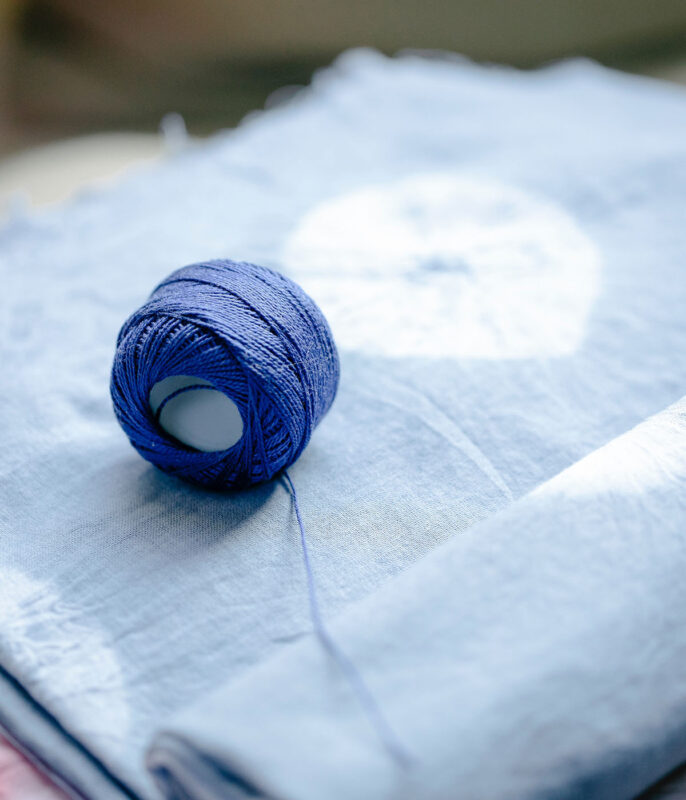Are you ready to dive into the world of textiles and see how this industry is evolving faster than a chameleon changes colors? Well, let me tell you, it’s an exciting journey for Indian fabrics!
Clothing is a basic human need, and the textile industry is one of the top contributors to our economy, accounting for around 14% of total industrial production. It’s no surprise that this industry is constantly evolving to keep up with our ever-changing fashion trends.
The United States is the largest producer of raw cotton and the biggest importer of natural textiles and garments in the world. Meanwhile, India is the third-largest fabric manufacturing industry and responsible for more than 6% of global textile production.
Now, let’s talk numbers! The global textile market has been on a steady rise, with a Compound Annual Growth Rate (CAGR) of 8.8% in 2022, increasing from $530.97 billion to $577.83 billion. Although the Russia-Ukraine conflict has caused some economic setbacks, the market is predicted to reach $722.32 billion in 2026, growing at a CAGR of 5.7%.
But here’s where things get even more exciting! The textile industry is always looking for new ways to improve their production processes and generate more revenue. Thanks to modern technology, we can now produce high-fiber fabrics that were once impossible to create. The industry works with a variety of materials, including cotton, jute, silk, synthetics, and wool, and employs two main processes: woven and non-woven.
And there’s more! The textile industry is also shifting towards cost efficiency and sustainability, making it even more exciting and inspiring. So, let’s take a look at some of the major trends that are driving this industry forward:
Increasing Demand for Natural Fibers
As we all know, sustainability is a hot topic right now, and the fabric manufacturing industry is no exception. There has been a noticeable increase in the demand for natural fibers, thanks to their unique properties that make them lighter and more durable than other synthetic fibers.
Natural fibers like cotton, silk, linen, wool, jute, and cashmere are used to create a wide range of products, including garments, construction materials, medical supplies, and automobile interiors. These fibers are particularly popular in countries like China, India, and the United States, where the textile industry has seen exponential growth in recent years.
What’s more, the industry is constantly evolving to keep up with consumers’ needs and wants. Textile manufacturing companies are focusing on improving their environmental performance by adopting new and innovative fiber processing techniques that preserve nature in the production process.
Wool and jute are known for their resilience, while silk is a luxurious and smooth fabric often used in upholstery and apparel. The industry players are always striving to match the latest trends and consumer demands, while also implementing eco-friendly processes to make a positive impact on the environment.
One of the latest advancements in the industry is the dissolution of cellulose ionic liquids and subsequent regeneration, which has been a game-changer for sustainable fashion. As technology continues to evolve, we can expect to see more innovative and eco-friendly solutions in the textile industry in the years to come.
Advancement in Technology
The textile manufacturers are experiencing a surge in demand for non-woven fabrics, and technology is playing a crucial role in meeting this demand. With rapid advancements, the industry is able to cater to the market needs efficiently.
Thermal energy is a critical component in the textile industry, particularly in the dye houses. This energy is generated from boilers and utilized in various machines such as dyeing machines, stenters, dryers, thermic fluid heaters, and more. By operating at low efficiency, the industry is able to optimize energy consumption.
However, most dye houses are dependent on state-provided electricity, which often results in power shortages due to the industry’s high energy consumption and limited access to electric equipment like motors.
Despite these challenges, the textile industry in India is predicted to evolve and adapt to meet global needs, thanks to the ongoing technological advancements and emerging trends.
In the value chain of the industry, processing is the key stage, and it involves various intricate variables such as adding easy-care, wrinkle-free properties in design and color. Synthetics and chemicals play a vital role in developing fibers and textiles, making it essential to optimize their usage and ensure sustainability.
Digital textile printing is becoming more popular
Fabric printing using inkjet-based methods is known as digital textile printing. With technological advancements, the textile manufacturing companies in India have seen an increase in the adoption of digital printing techniques, including Dye Sublimation Printing, and this trend is predicted to continue.
Digital textile printing offers numerous advantages, which explain why it is so popular in this sector:
- Cost-effective: Digital printers require less material than traditional textile technology. Smaller textile businesses can fulfil small orders without incurring additional costs.
- Quick turnaround: Instead of creating new rotary screens for every minor error, you can quickly modify your design or fix digital designs from your computer and print them.
- Flexibility: Digital printing provides unlimited design flexibility, with graphics displayed on as many screens as needed.
- Sustainability: Digital printing is precise and distributes ink onto fabric accurately, resulting in minimal ink waste or unnecessary chemical waste that could harm the environment.
- Recent advancements in digital printing technology have significantly benefited the textile industry, and according to a study of the textile market, it is likely to have a considerable impact on the industry in the future.
FAQs
Which types of fabrics are currently in demand in India?
The Indian fabric market is diverse, and the demand for different types of fabrics varies depending on the season, occasion, and region. However, there are some fabrics that are currently in high demand across the country.
Cotton is a popular fabric in India, and it remains in high demand due to its comfort, breathability, and affordability. Indian consumers prefer cotton-based fabrics for daily wear, including salwar suits, sarees, and kurtas.
Silk is another fabric that has been in demand in India for centuries. It is a luxury fabric that is used for special occasions, including weddings, festivals, and formal events. The traditional silk fabrics like Banarasi silk, Kanchipuram silk, and Bhagalpuri silk remain popular, but modern variants like Tussar silk and Eri silk are also gaining popularity among Indian consumers.
In recent years, there has been a growing demand for sustainable and eco-friendly fabrics like organic cotton, linen, and hemp. These fabrics are not only environmentally friendly, but they also provide a unique texture and feel to the clothing, making them popular among the fashion-conscious youth.
What are the current trends in textile industry?
The textile industry is continuously evolving, and it is adapting to the changing needs of the consumers. Some of the current trends in the textile industry include the following:
Sustainability: Consumers are becoming more aware of the environmental impact of their clothing, and they are demanding sustainable and eco-friendly fabrics. This trend has led to an increase in the use of recycled fibers, organic cotton, and natural dyes in textile production.
Digital Printing: Digital printing technology has revolutionized the textile industry by providing fast and cost-effective printing options. Digital printing allows textile manufacturer to create complex designs, use a wide range of colors, and produce small quantities of fabric without incurring additional costs.
Smart Fabrics: Advances in textile technology have led to the development of smart fabrics that can monitor vital signs, control temperature, and adjust to the wearer's movements. These fabrics are gaining popularity in the sportswear and healthcare industries.
Innovative Designs: The use of unique and innovative designs in textile production is a current trend that is popular among consumers. Manufacturers are experimenting with new patterns, textures, and color combinations to create unique and visually appealing fabrics.
What are the challenges faced by Indian fabric manufacturers in terms of competition?
The Indian fabric manufacturing industry faces several challenges in terms of competition, including:
Global Competition: Indian fabric manufacturers face competition from global players who can produce fabrics at lower costs due to economies of scale and advanced technology. Indian textile manufacturer have to compete with Chinese, Bangladeshi, and Vietnamese manufacturers who have dominated the global textile industry in recent years.
Cost of Production: The cost of production is a significant challenge for Indian fabric manufacturers. The cost of raw materials, labor, and energy has increased in recent years, making it difficult for manufacturers to remain competitive. Manufacturers are also facing challenges related to compliance with environmental regulations, which adds to their production costs.
Lack of Skilled Labor: The Indian textile industry is facing a shortage of skilled labor, which is impacting the quality of the products produced. Manufacturers are struggling to find workers with the necessary skills and expertise to operate the advanced machinery used in fabric production.
Lack of Innovation: Indian fabric manufacturers need to be more innovative to remain competitive in the global market. They need to invest in research and development to create new fabrics, designs, and technologies to meet the changing demands of the consumers.
What is the future outlook for the Indian fabric manufacturing industry?
The future of the Indian fabric manufacturing industry is bright, as it has the potential to become a global leader in textile production. The industry is expected to grow at a significant rate due to the growing demand for textiles in both domestic and international markets.
The Indian government has taken several initiatives to support the growth of the textile industry, including the introduction of favourable policies, financial incentives, and infrastructure development. The government's 'Make in India' campaign is also expected to boost the growth of the textile industry by encouraging foreign investments and promoting local manufacturing.
The industry's future growth is also likely to be driven by innovation and sustainability. Indian manufacturers are adopting sustainable practices and investing in research and development to create eco-friendly fabrics and innovative designs. They are also embracing digital printing technology to create unique and customizable fabrics, which is expected to boost their competitiveness in the global market.
Overall, the Indian fabric manufacturing industry is poised for growth in the coming years, and manufacturers who invest in innovation, sustainability, and skilled labor are likely to benefit from the industry's growth potential.

